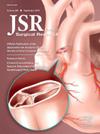Trimethylamine N-Oxide and Smoking Are Associated With the Progression of Thromboangiitis Obliterans
IF 1.8
3区 医学
Q2 SURGERY
引用次数: 0
Abstract
Introduction
Thromboangiitis obliterans (TAO) is potentially associated with smoking, although its precise pathogenesis remains unclear. Trimethylamine N-oxide (TMAO) has been implicated in the induction of various cardiovascular and cerebrovascular diseases. However, the role of TMAO in TAO has not been reported. This study aimed to investigate the relationship between smoking, TMAO, and TAO.
Materials and methods
Thirty-three patients diagnosed with TAO and hospitalized for treatment between January 2018 and July 2024 were included in the study. Healthy smokers (n = 38) and nonsmokers (n = 35) were randomly recruited and matched for age, sex, and education level as controls. Subsequently, we analyzed their clinical characteristics, levels of TMAO, and immune and inflammatory markers.
Results
Patients with TAO exhibited significantly higher levels of TMAO, Toll-like receptor 4 (TLR4), receptor for advanced glycation end products, interleukin (IL)-1β, IL-18, tumor necrosis factor-alpha, high mobility group box 1, nuclear factor-κB (NF-κB), and phosphorylated NF-κB (pNF-κB) than those in the smoking and nonsmoking control groups (all P < 0.05). The smoking control group also exhibited significantly higher levels of TMAO, TLR4, IL-1β, NF-κB, and pNF-κB (all P < 0.05) than the nonsmoking control group. TMAO, IL-1β, and tumor necrosis factor-alpha levels were significantly higher in the underage smoking group (all P < 0.05) than in the adult smoking group. The level of TMAO was significantly correlated with the Rutherford classification in patients with TAO, patients' smoking status (including total years of smoking and average daily cigarette consumption), and immune and inflammatory markers (all P < 0.05).
Conclusions
These findings indicate that gut microbiota plays a significant role in the pathogenesis of TAO. TMAO is likely involved in the pathogenesis and progression of TAO, with smoking acting as a contributing factor. The underlying mechanism may involve the activation of immune-inflammatory pathways, specifically the high mobility group box 1–receptor for advanced glycation end products/TLR4-NF-κB pathway.
三甲胺n -氧化物和吸烟与血栓闭塞性脉管炎的进展有关
血栓闭塞性脉管炎(TAO)可能与吸烟有关,尽管其确切的发病机制尚不清楚。三甲胺n -氧化物(TMAO)与各种心脑血管疾病的诱导有关。然而,TMAO在TAO中的作用尚未见报道。本研究旨在探讨吸烟、氧化三甲胺和TAO之间的关系。材料与方法纳入2018年1月至2024年7月期间确诊为TAO并住院治疗的33例患者。随机招募健康吸烟者(n = 38)和不吸烟者(n = 35),并根据年龄、性别和教育水平进行匹配作为对照。随后,我们分析了他们的临床特征、氧化三甲胺水平、免疫和炎症标志物。结果TAO患者TMAO、toll样受体4 (TLR4)、晚期糖基化终产物受体、白细胞介素(IL)-1β、IL-18、肿瘤坏死因子- α、高迁移率组1、核因子-κB (NF-κB)、磷酸化NF-κB (pNF-κB)水平均显著高于吸烟和不吸烟对照组(P <;0.05)。吸烟对照组TMAO、TLR4、IL-1β、NF-κB和pNF-κB水平均显著升高(P <;0.05),高于不吸烟对照组。未成年吸烟组TMAO、IL-1β和肿瘤坏死因子α水平显著升高(P <;0.05)高于成年吸烟组。TMAO水平与TAO患者的卢瑟福分类、患者的吸烟状况(包括吸烟总年数和平均每日吸烟量)、免疫和炎症指标(均P <;0.05)。结论肠道菌群在TAO发病机制中起重要作用。氧化三甲胺可能参与了TAO的发病和进展,而吸烟是一个促成因素。潜在的机制可能涉及免疫炎症途径的激活,特别是晚期糖基化终产物的高迁移率组盒1受体/TLR4-NF-κB途径。
本文章由计算机程序翻译,如有差异,请以英文原文为准。
求助全文
约1分钟内获得全文
求助全文
来源期刊
CiteScore
3.90
自引率
4.50%
发文量
627
审稿时长
138 days
期刊介绍:
The Journal of Surgical Research: Clinical and Laboratory Investigation publishes original articles concerned with clinical and laboratory investigations relevant to surgical practice and teaching. The journal emphasizes reports of clinical investigations or fundamental research bearing directly on surgical management that will be of general interest to a broad range of surgeons and surgical researchers. The articles presented need not have been the products of surgeons or of surgical laboratories.
The Journal of Surgical Research also features review articles and special articles relating to educational, research, or social issues of interest to the academic surgical community.

 求助内容:
求助内容: 应助结果提醒方式:
应助结果提醒方式:


